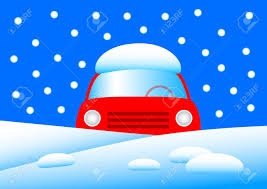These days, weather forecasts are so frequent and usually accurate, that it can't really be said that the snow or ice was a surprise, so if it's forecast, ask yourself if your car journey is really necessary.
If it's essential that you go out in snow and ice, look after yourself by carrying a spade, warm clothing, a warm drink and some food in case things get really held up.
I once lived in Wembley and getting home from work one night in a snowstorm (a necessary journey!), I arrived at the bottom of Blackbird Hill, near the stadium at about 6:30 pm and it was gridlock on ice, and I didn't reach the top (about half a mile) until 11pm! I really could have used a warm drink and some food that night, as well as a spade.
Driving in snow.
Falling snow will reduce your visibility, so use your dipped headlights, as you would in heavy rain or fog. Snow that is falling, or freshly fallen will not really cause you any problems, provided you stick to a few basic rules:
- Increase the gap between you and the vehicle in front.
- Test your brakes every so often. Packed snow behind the front wheels and around the brakes can affect steering and braking.
- Keep your windscreen and lights clear, by hand if necessary, so you can see and be seen.
- Clear your rear window before setting off, and keep it clear.
Remember that snow will blanket any road markings, so that even familiar roads can appear strange, so take extra care.
Braking on Snow and Ice.
All but the most gentle braking will lock your wheels on packed snow and ice.
If your front wheels lock, you can't steer. If you can't steer, you're in trouble. It would be like driving blindfolded!
Get into a lower gear earlier, allowing your speed to drop, and then brake gently and early to keep your speed controlled.
Braking distances on ice can easily be ten times further than normal.
Anti-lock brakes will not compensate for poor judgement and excessive speed on snow and ice, as they cannot help your tyres to stay in contact with the road surface.
Ice.
Driving on ice should be avoided whenever possible. It's even more dangerous when the roads are just beginning to freeze or thaw, as the combination of water and ice makes an extremely slippery mixture.
Black Ice.
This type of ice is especially dangerous, as it's invisible. It's usually caused by rain freezing on the road surface as it falls, and your steering will feel very light, as if you were aquaplaning.
If the road looks wet, but there is no sound from the tyres, you will be on ice, so,
- Keep your speed down.
- Treat every control - brakes, gas pedal, steering, clutch and gears - very delicately.
Call us on 01452313713.
Warm Regards,
John Lowe,

No comments:
Post a Comment